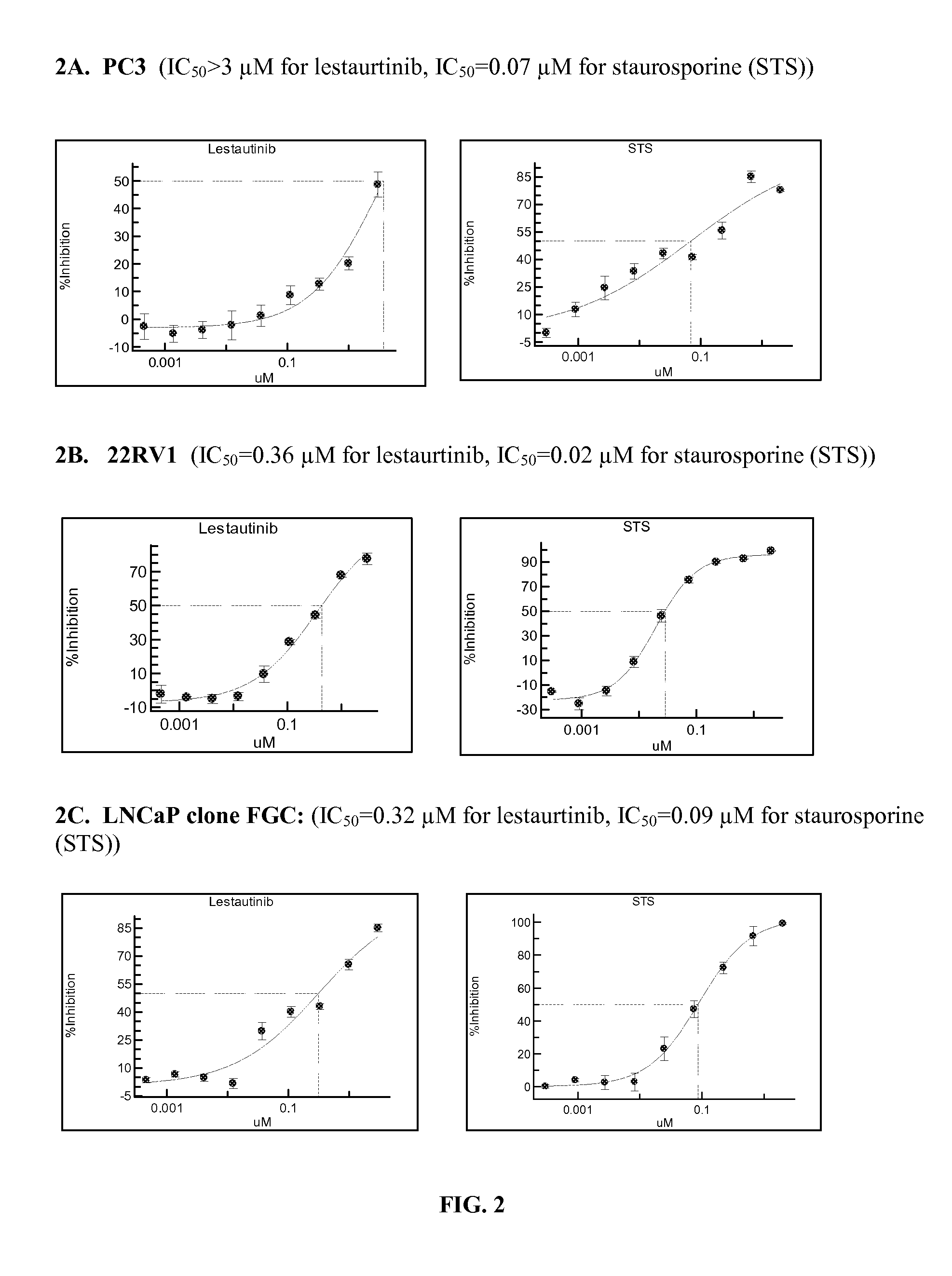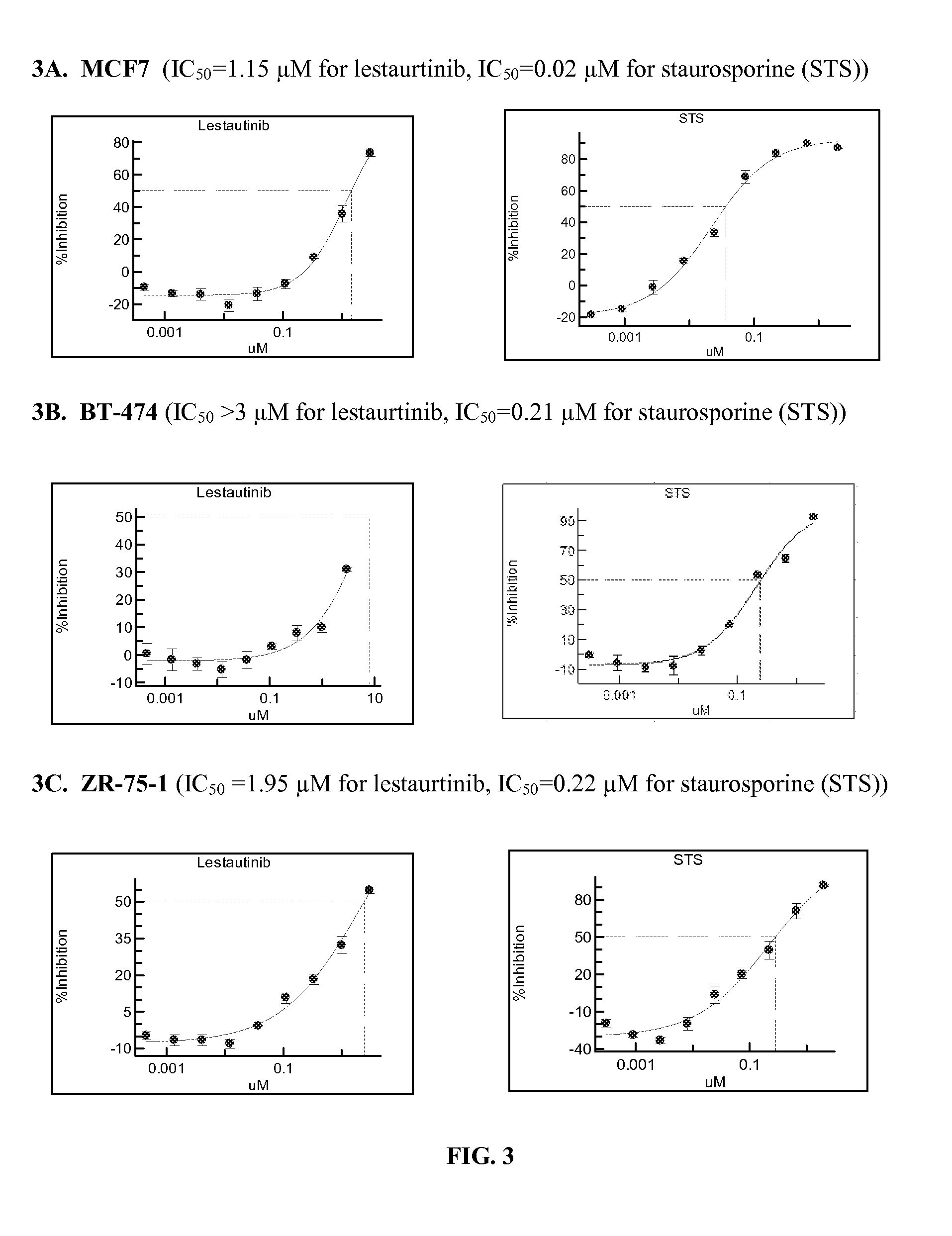Rationale-based design of a targeted therapy for cancer
a cancer and cancer technology, applied in the field of rationale-based design of cancer targeted therapy, can solve the problems of spop's ability to induce ubiquitin-dependent degradation of src-3, poor prognosis, and prostate cancer patients with lestaurtinib failing to achieve the primary clinical endpoint, etc., to achieve the effect of reducing expression levels and/or pathway activity
- Summary
- Abstract
- Description
- Claims
- Application Information
AI Technical Summary
Benefits of technology
Problems solved by technology
Method used
Image
Examples
example 1
Materials and Methods
[0163]Materials and cell lines: Prostate, breast and gastric cancer cell lines and their sources are shown in the table below. The growth condition of each tumor cell line is shown in the subsequent table per recommendation from ATCC. Staurosporine (from Sigma, Cat. No. S4400-1 mg, Lot No. 017k4059) and Lestaurtinib (from Sigma, Cat. No. C7869-1 mg, Lot No. 072M4750V) were dissolved in DMSO (Sigma).
Cell LineVendorCat#DescriptionPC-3ATCCCRL-1435prostate, adenocarcinoma22RV1SIBSTCHu 100prostate, carcinomaDU145ATCCHTB-81prostate, carcinomaLNCaP CloneATCCCRL-1740prostate, carcinomaFGCAGSATCCCRL-1739stomach, gastric adenocarcrnomaMKN-45JCRBJCRB0254stomach, gastric adenocarcinomaHs746TATCCHTB-135stomach, gastric carcinomaNCI-N87ATCCCRL-5822stomach, gastric carcinomaMCF7ATCCHTB-22breast, adenocarcinoma (pleuraleffusion)BT-474ATCCHTB-20breast, ductal carcinomaZR-75-1ATCCCRL-1500breast, ductal carcinomaSeeding DensityIncuba-(96-well,tionCell LineComplete mediumper well)T...
example 2
Searching for SPOP Substrates
[0170]PubMed search of SPOP-dependent protein degradation revealed that SRC-3, Daxx, and Gli are the known substrates of SPOP (J Biol Chem. 2006; 281:12664-72, Oncogene 2011; 30:4350-64, Dev Cell. 2006; 10: 719-29). We searched NCBI database with an attempt to identify other SPOP substrates that are involved in androgen receptor signaling. Structural database in the NCBI revealed that three peptide sequences can interact with SPOP. These include:
[0171]KAASADSTTEGTPAD
(http: / / www.ncbi.nlm.nih.gov / Structure / mmdb / mmdbsrv.cgi?uid=77512)
[0172]NTLFPDVSSSTH
(http: / / www.ncbi.nlm.nih.gov / Structure / mmdb / mmdbsrv.cgi?uid=77549)
[0173]DEVTSTTSSS (http: / / www.ncbi.nlm.nih.gov / Structure / mmdb / mmdbsrv.cgi?uid=77550)
[0174]All three peptide sequences are consistent with the consensus sequence of multiple Ser / Thr followed by an acidic residue previously reported (Proc Natl Acad Sci USA. 2009; 106: 21191-6). We performed a BLAST search using the consensus sequences in order to i...
example 3
Sensitivity of Prostate, Breast and Gastric Cancer Cells Against Lestaurtinib
[0175]To examine the feasibility of using lestaurtinib to treat prostate, breast, gastric and other cancers, three prostate cancer cell lines with varying degrees of androgen sensitivity, PC3 (androgen insensitive), DU145 (androgen insensitive), and LNCaP (androgen sensitive), were investigated in their sensitivity against lestaurtinib (FIG. 2). Three breast cancer cell lines, MCF7, BT-474, and ZR-75-1 (FIG. 3), and four gastric cancer cell lines, AGS, MKN-45, Hs746T and NCI-N87 (FIG. 4), were also tested to determine their IC50 against lestaurtinib and compared with staurosporine, a lestaurtinib homologue with much broader kinase inhibitory activity. All tumor cells were treated with DMSO (control) or 10, 30, 100, 300, 1000, or 3000 nM lestaurtinib or staurosporine for 48 hours. MTT assays were then performed to determine the impact of drug treatment on tumor cell viability. IC50 was determined as the conc...
PUM
| Property | Measurement | Unit |
|---|---|---|
| diameter | aaaaa | aaaaa |
| weight percent | aaaaa | aaaaa |
| particle sizes | aaaaa | aaaaa |
Abstract
Description
Claims
Application Information
 Login to View More
Login to View More - R&D
- Intellectual Property
- Life Sciences
- Materials
- Tech Scout
- Unparalleled Data Quality
- Higher Quality Content
- 60% Fewer Hallucinations
Browse by: Latest US Patents, China's latest patents, Technical Efficacy Thesaurus, Application Domain, Technology Topic, Popular Technical Reports.
© 2025 PatSnap. All rights reserved.Legal|Privacy policy|Modern Slavery Act Transparency Statement|Sitemap|About US| Contact US: help@patsnap.com



